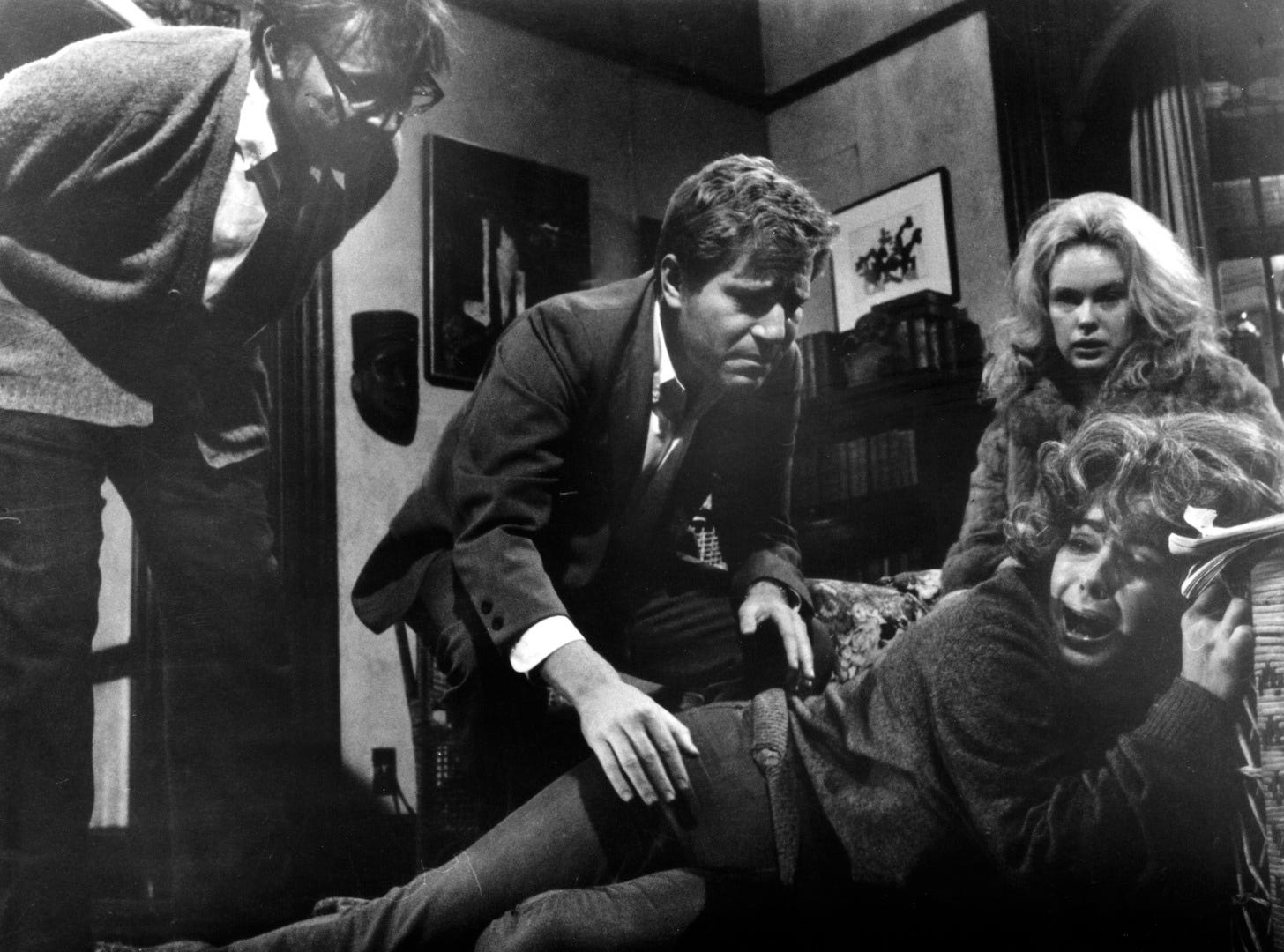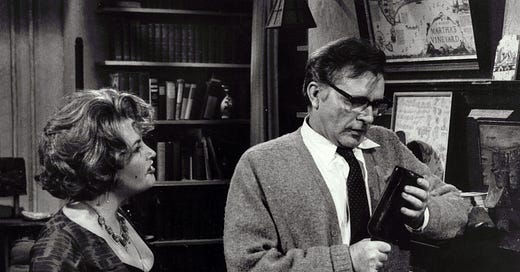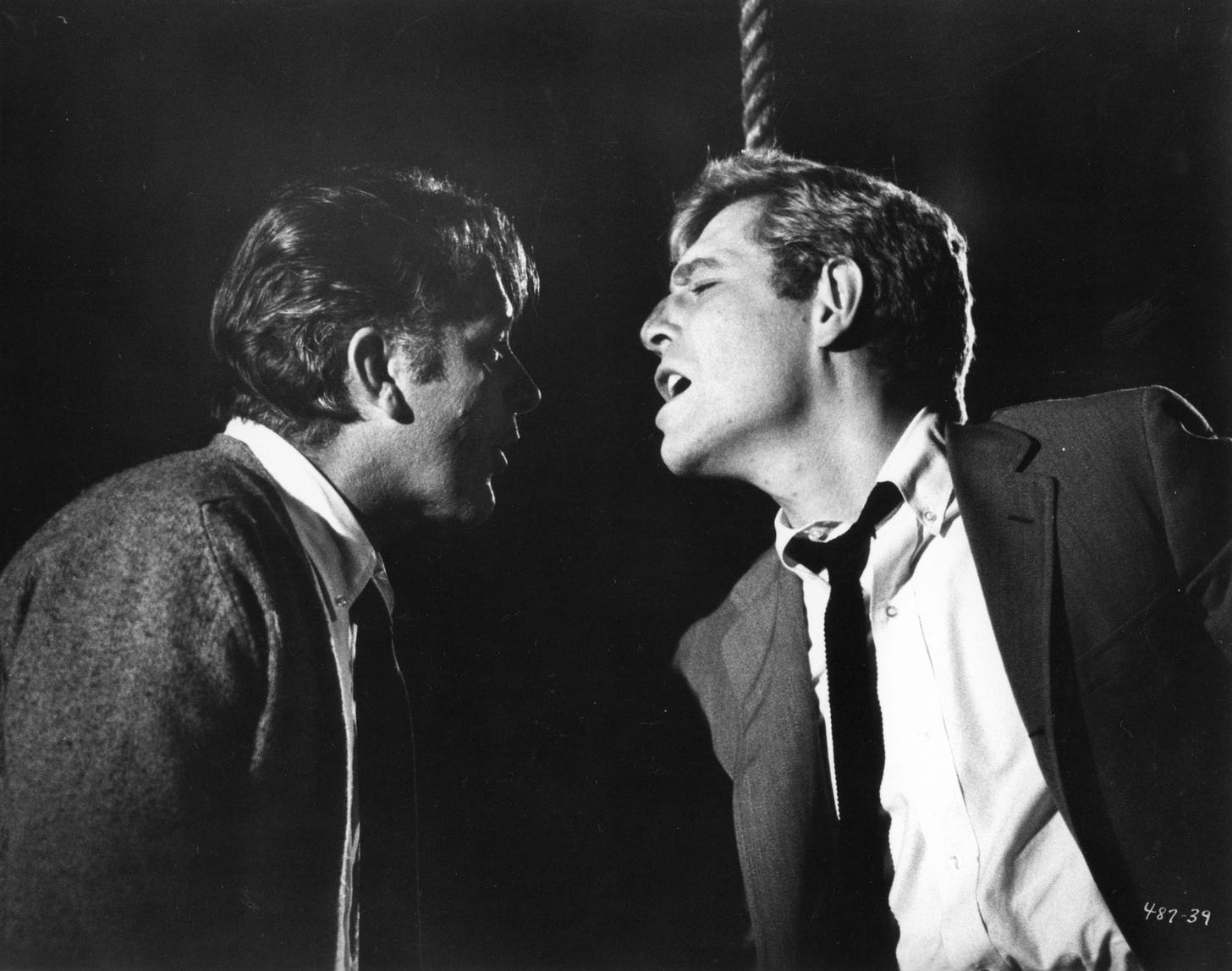Spoilers for Who’s Afraid of Virginia Woolf? (1966)
Delusion, and the damage it can do to a person, is at the heart of Mike Nichols’ directorial debut Who’s Afraid of Virginia Woolf?, adapted by Ernest Lehman from Edward Albee’s 1962 play of the same name.
It focuses on the crumbling relationship between associate professor George and his wife Martha (played by the fiery on-again, off-again couple Richard Burton and Elizabeth Taylor). Their dissatisfaction with their lives becomes a weapon that they use on each other, and on a young couple that they invite back to their house; new biology professor Nick (George Segal) and Honey (Sandy Dennis).
This sets off an evening of psychological warfare, in which none of the four participants will win. Martha, whose father is the president of the university, sets out to humiliate George. Mocking him for never progressing beyond associate professor, despite her father providing opportunities. George is more morose, verbally attacking Martha for her drunkenness and accusing her of whittling him down to a shell of his former self.
It's through George that the themes of delusion, and destroying the delusions come to the fore. After being routinely humiliated by Martha during the opening third of the film – barring one incredibly sweet moment before Nick and Honey arrive that indicates that these two still care about each other – George is left alone with the younger professor. George needles Nick, trying to uncover his intentions.
The young man puts on a show over his happy relationship and his career prospects, but there have been visible cracks in this façade and George pounces on them. In opening up about the threat he considers Nick to be, George pulls the story out of the man. Nick admits that he was attracted to Honey because of her wealthy family and only married her because of a phantom pregnancy. He goes further, saying that he fully intends to charm and sleep his way up the ladder, and agrees that Martha would be a good place to start.
Despite appearing to be the perfect couple, Nick and Honey’s relationship is also built on a delusion. This delusion is the same one that George and Martha have allowed to control their lives. The idea of the nuclear, happy family.
Because the play and the film were made at a time when there were massive social changes underway. The counterculture and civil rights movement heightened generational tensions, and there was a growing acceptance that you could not maintain relationships on traditional values alone. Women were seeking more independence and the divorce rate in America started to creep up as it became clear that a housewife was not the only option for a woman.
In Who’s Afraid of Virginia Woolf? we see the damage that adhering to these traditional values can cause. Nick only married Honey because he believed her to be pregnant, and Honey isn’t completely innocent in this as it’s hinted later that she was with child and got a secret abortion once they were married. By adhering to the expectations of the time, and buying into the delusion that there is only one route to a happy life, Nick finds himself in a relationship that is outwardly happy but filled with resentment.
And the same is true for George and Martha. Unable to conceive, they create a secret fantasy; a child for whom they imagine a successful life. This private delusion keeps them together, in the same way that many unhappy couples attempt to stay together for the kids, but it also adds to the resentment they feel towards each other. Much of Martha’s vitriol towards George is focused on his masculinity. She regularly calls him a ‘cluck’, which could be linked to the idea of a coward – a chicken – or a play on cuck, or cuckold.

The implication that he is the one who is unable to impregnate her is compounded by his other perceived failures as both a husband and man.
Yet George is the one character who actively tries to break the delusions. He calls out Nick’s hypocrisy and humiliates the young couple in a game of ‘Get the Guests’ when the four visit a bar late in the film. He recognises the falsity of their relationship, just as he sees it in his own. And when we get to the end of the film, he forcibly breaks down the shared delusions between him and Martha.
Rather than allow Martha to continue discussing their imaginary child with the guests, he adds a tragedy to the story, telling her that their son has died. It’s a definite end to the delusion and forces a grieving Martha to step out of the fantasy.
Nick and Honey leave, shell-shocked and uncertain about their future. George and Martha go to bed. Neither couple can continue to live the way they have before, and while the film gives us no closure on whether the relationships survive when George gently takes Martha’s hand and leads her upstairs, there’s a clear suggestion that facing those problems head-on will be better for them than pretending the problems don’t exist.
Director: Mike Nichols
Writer: Ernest Lehman. Based on the play Who’s Afraid of Virginia Woolf? by Edward Albee
Starring: Elizabeth Taylor, Richard Burton, George Segal, Sandy Dennis








